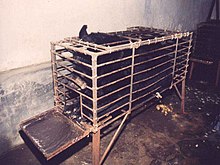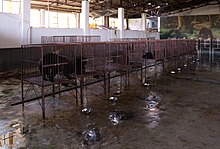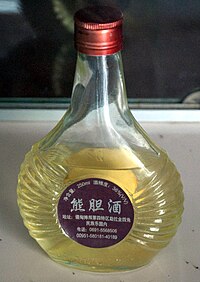Bile bear: Difference between revisions
No edit summary |
m Reverted 1 edit by 114.76.66.5 (talk) to last revision by Tomato expert1. (TW) |
||
| Line 1: | Line 1: | ||
[[File:Bile bear.jpg|right|thumb|A bile bear in a “crush cage” on Huizhou Farm, China.]] |
|||
[[File:Ursus t. japonicus Ueno Zoo.jpg|right|thumb|An Asian black bear (''[[Ursus thibetanus]]'').]] |
[[File:Ursus t. japonicus Ueno Zoo.jpg|right|thumb|An Asian black bear (''[[Ursus thibetanus]]'').]] |
||
'''Bile bears''' or '''battery bears''' are [[Asian black bear]]s (''Ursus thibetanus'') kept in captivity to harvest [[bile]], a digestive juice produced by the [[liver]] and stored in the [[gall bladder]]. When extracted, the bears’ bile is a valuable [[commodity]] for sale as an ingredient in [[traditional Chinese medicine]].<ref>http://www.china.org.cn/video/2012-02/20/content_24679572.htm</ref> The bears are also known as '''[[moon bear]]s''' because of the cream-colored crescent moon shape on their chest. The Asian black bear, the one most commonly used on bear farms, is listed as vulnerable on the [[World Conservation Union]]'s (IUCN's) [[Red List of Threatened Animals]]. Bear bile collection occurs in [[China]], [[South Korea]],<ref name="koreajoongangdaily.joinsmsn.com">http://koreajoongangdaily.joinsmsn.com/news/article/article.aspx?aid=2911817</ref> Laos<ref>{{cite news| url=http://www.telegraph.co.uk/news/worldnews/asia/laos/7950161/Inside-a-bear-bile-farm-in-Laos.html | location=London | work=The Daily Telegraph | first=Fiona | last=MacGregor | title=Inside a bear bile farm in Laos | date=19 August 2010}}</ref> and [[Vietnam]].<ref name="BBC">{{cite news|url= http://news.bbc.co.uk/2/hi/science/nature/6742671.stm|title=BBC Test kit targets cruel bear trade | date=2007-06-11 | accessdate=2010-01-01|archiveurl = http://www.webcitation.org/5uKg09Jgj |archivedate = 2010-11-18|deadurl=no |work=BBC News |first=Richard |last=Black}}</ref> |
'''Bile bears''' or '''battery bears''' are [[Asian black bear]]s (''Ursus thibetanus'') kept in captivity to harvest [[bile]], a digestive juice produced by the [[liver]] and stored in the [[gall bladder]]. When extracted, the bears’ bile is a valuable [[commodity]] for sale as an ingredient in [[traditional Chinese medicine]].<ref>http://www.china.org.cn/video/2012-02/20/content_24679572.htm</ref> The bears are also known as '''[[moon bear]]s''' because of the cream-colored crescent moon shape on their chest. The Asian black bear, the one most commonly used on bear farms, is listed as vulnerable on the [[World Conservation Union]]'s (IUCN's) [[Red List of Threatened Animals]]. Bear bile collection occurs in [[China]], [[South Korea]],<ref name="koreajoongangdaily.joinsmsn.com">http://koreajoongangdaily.joinsmsn.com/news/article/article.aspx?aid=2911817</ref> Laos<ref>{{cite news| url=http://www.telegraph.co.uk/news/worldnews/asia/laos/7950161/Inside-a-bear-bile-farm-in-Laos.html | location=London | work=The Daily Telegraph | first=Fiona | last=MacGregor | title=Inside a bear bile farm in Laos | date=19 August 2010}}</ref> and [[Vietnam]].<ref name="BBC">{{cite news|url= http://news.bbc.co.uk/2/hi/science/nature/6742671.stm|title=BBC Test kit targets cruel bear trade | date=2007-06-11 | accessdate=2010-01-01|archiveurl = http://www.webcitation.org/5uKg09Jgj |archivedate = 2010-11-18|deadurl=no |work=BBC News |first=Richard |last=Black}}</ref> |
||
==History== |
==History== |
||
Revision as of 07:32, 22 April 2013


Bile bears or battery bears are Asian black bears (Ursus thibetanus) kept in captivity to harvest bile, a digestive juice produced by the liver and stored in the gall bladder. When extracted, the bears’ bile is a valuable commodity for sale as an ingredient in traditional Chinese medicine.[1] The bears are also known as moon bears because of the cream-colored crescent moon shape on their chest. The Asian black bear, the one most commonly used on bear farms, is listed as vulnerable on the World Conservation Union's (IUCN's) Red List of Threatened Animals. Bear bile collection occurs in China, South Korea,[2] Laos[3] and Vietnam.[4]
History
Bear bile has historically been used as an ingredient in traditional Chinese medicine. The traditional way to acquire bear bile was to kill a wild animal and remove its gall bladder. In the early 1980s, however, bile bear farms began appearing in North Korea, eventually spreading to other regions.[1] The practice of bile bear farming has been ethically controversial because of cruel treatment of the bears alleged by bile-farming opponents.[citation needed] The Chinese government, however, has attempted to justify bear farming, claiming that the farms promote captive breeding and reduce the need to hunt and kill wild bears. Nonetheless, the bears continue to be hunted in the wild in order to supply bears to the bile farms, allegedly because of difficulties with captive breeding[2], where a gall bladder can fetch up to $3000 - $5000 USD.[3]
Living conditions

To facilitate the bile milking process, the bears are commonly kept in extraction cages, also known as crush cages, that measure around 2.6 feet x 4.4 feet x 6.5 feet (79 cm x 130 cm x 200 cm) for an animal that weighs between 110 to 260 pounds (50 to 118 kg).[citation needed] While this allows for easier access to the abdomen, it also prevents the bears from being able to stand upright, or in some cases move at all. Living for 10–12 years under such circumstances results in severe mental stress and muscle atrophy.[5] The Chinese media reported an incident in which a mother bear, having escaped her cage, strangled her own cub and then killed herself by intentionally running into a wall.[6] In two model Chinese bile farms, the Humane Society of the United States (HSUS) reports that the bears are moved to the crush cages for milking, but the rest of the time live in a cage large enough to stand and turn around.[citation needed]
The World Society for the Protection of Animals sent researchers to 11 bile farms.[citation needed] They reported seeing bears moaning, banging their heads against their cages, and chewing their own paws. The mortality rate is high. Bile bears suffer from a variety of physical problems which include loss of hair, malnutrition, stunted growth, muscle mass loss, and often have their teeth and claws extracted.[citation needed] When the bears stop producing bile after a few years, they are usually killed for their meat, fur, paws and gall bladders. Bear paws are considered a delicacy, and have been seen priced at $250.[citation needed]
Extraction methods
According to the HSUS, the bile is usually extracted twice a day through an implanted tube, producing 10–20 mL of bile each time; the process is believed to be painful, as the bears can be seen moaning and chewing their paws while being milked. Other methods include pushing a hollow steel stick through the bear's abdomen. The use of metal catheters has been banned, though HSUS writes that bile bears are still seen with catheters in them.[citation needed]
The "free drip" method is regarded as more humane. A permanent hole or fistula is made in the bear's abdomen and gall bladder, from which bile drips out freely. The wound is vulnerable to infection and bile can bleed back into the abdomen, causing a high mortality rate. Sometimes the hole is kept open with a perspex catheter, which HSUS writes causes severe pain. Additionally, the bears are sometimes fitted with an iron vest, as otherwise they may hit their stomach, possibly in response to the pain. [citation needed]
Statistics
Wild population
There is no definitive estimate of the number of Asian black bears in the wild: Although their reliability is unclear, rangewide estimates of 5–6,000 bears have been presented by Russian biologists. Rough density estimates without corroborating methods or data have been made in India and Pakistan, resulting in estimates of 7–9,000 in India and 1,000 in Pakistan. Unsubstantiated estimates from China give varying estimates between 15–46,000, with a government estimate of 28,000.[7] Some estimates put the total Asia-wide population as low as 25,000.
Farmed population
China
In July 2000, Animals Asia Foundation, a Hong Kong based charity, signed an agreement with the Chinese government to remove 500 endangered Asian black bears from bile farms in Sichuan province and work towards ending the practice. Today, the China Bear Rescue has placed 219 previously farmed moon bears at a Sanctuary in Chengdu, and is helping to advance the concept of animal welfare in China.
The World Society for the Protection of Animals (WSPA) conducted a study in 1999 and 2000, and estimated that there were 247 bear bile farms in China, holding 7,002 bears, though the Chinese government called the figures "pure speculation."[citation needed] The Chinese consider bear farms a way to reduce the demand on the wild bear population. Officially 7,600 captive bears are farmed in China. According to Chinese officials, 10,000 wild bears would need to be killed each year to produce as much bile.[8] The government sees farming as a reasonable answer to the loss of wild bears from poaching, and at the same time are indifferent to the cruelty issues that concern Western animal rights activists. However, the government's agreement to allow the rescue of 500 bears may represent a softening of this stance.[citation needed]
Vietnam
There are estimated to be 4,000 bile bears in Vietnam, where their bile can sell for 100,000 dong (~US$6.25) per millilitre (with 37,500 dong a week regarded as the poverty line for an urban resident).[citation needed]
Korea
In 2009, according to the Korean Environment Ministry, there were 1,374 bears raised at 74 farms across South Korea. In Korea it is legal to raise bears for bile and bears older than 10 years old can be harvested for their paws and organs.[2] By 2012, it is estimated the number of bears in Korean farms will have risen to about 1,600.[citation needed]
Laos
In Laos, bear bile can sell for 120,000 kip (~US$15) per millilitre (with 240,000 kip being the average monthly wage in the country).[9] the number of bile bears is estimated at more than 100 individuals.[citation needed]
Bile trade
The monetary value of the bile comes from the traditional prescription of bear bile by doctors practicing traditional Chinese medicine. Bear bile contains ursodeoxycholic acid (UDCA), which is believed to reduce fever, protect the liver, improve eyesight, break down gallstones, and act as an anti-inflammatory.[citation needed] The high demand for the bile has led to the introduction of intensive farming of bears. Because only minute amounts are used in traditional Chinese medicine, a total of 500 kg[citation needed] of bear bile is used by practitioners every year, but according to WSPA more than 7,000 kg[citation needed] is being produced, with the surplus is being used in non-essential products such as wines, eyedrops, and general tonics.[citation needed]
In January 2006, the Chinese State Council Information Office held a press conference in Beijing, during which the government said that it was enforcing a "Technical Code of Practice for Raising Black Bears," which "requires hygienic, painless practice for gall extraction and make strict regulations on the techniques and conditions for nursing, exercise and propagation."[10] However, a 2007 Veterinary Report published by the Animals Asia Foundation stated that the Technical Code was not being enforced and that many bears were still spending their entire lives in small extraction cages without free access to food or water. AAF also noted that the free-dripping technique promoted in the Technical Code was unsanitary as the fistula created to access the gall bladder allowed for an open portal through which bacteria could infiltrate the abdomen. The AAF Vet Report also stated that surgeries to create free-dripping fistulas caused bears great suffering as they were performed without appropriate antibiotics or pain management and the bears were repeatedly exposed to this process as the fistulas often healed over. The free-dripping method still requires the bears to be prodded with a metal rod when the wound heals over and, under veterinary examination, some bears with free-dripping fistulas were actually found to have clear perspex catheters permanently implanted into their gall bladders. In addition to the suffering caused by infection and pain at the incision site, 28% of fistulated bears also experience abdominal hernias and more than a third eventually succumb to liver cancer, believed to be associated with the bile-extraction process.
Pharmacology
The active therapeutic substance in bear bile—and in the bile of all mammals—is ursodeoxycholic acid (UDCA). Before the manufacture of UDCA by pharmaceutical companies, bear bile was prescribed by practitioners of traditional Chinese medicine because it contained a higher percentage of UDCA than the bile of other mammals. However, modern chemistry has made this fact irrelevant. Today, pharmaceutical-grade UDCA is now collected from slaughterhouses, then purified and packaged under trade names such as Ursosan, Ursofalk, Actigall, and UrsoForte. Chinese doctors have also endorsed several herbal substitutes, which provide a cheap, effective and readily available alternative.[citation needed]
Substances in mammalian bile other than UDCA, such as cholesterol, have never been demonstrated to have any healing effect in humans. Despite this observation and the availability of affordable pharmaceutical-grade UDCA, some practitioners of traditional Chinese medicine continue to prescribe whole bear bile for their patients and reject any sort of modern substitute.[citation needed]
Rescue centers
In China, there are two moon bear rescue centers, one in the Sichuan province and one in the Yunnan province. The rescue centers have already rescued approximately 300 bile bears. The bears are kept at the rescue centers where they are allowed to run around and play. The rescue centers not only rescue bile bears but also rescue some brown bears, dogs, cats, etc. The rescue center was opened by Jill Robinson from England.[citation needed]
It is claimed by animal welfare advocate that bear bile is not needed to make traditional Chinese medicine or other products as many herbs, such as coptis or rhubarb, can be used as alternatives for bear bile.[citation needed]
Businesses
In 2010 Guizhentang Pharmaceutical company was one of the most successful bile extraction company in China, paying some 10 million yuan in taxes.[11] By 2012 the company tried to go public in the Shenzhen stock exchange and met heavy challenges from activists, internet users and protesters.[12] This was followed by a number of controversies along with public interviews.[13]
See also
- Animals Asia Foundation
- Free the Bears Fund
- Jill Robinson
- Snake wine, a rice wine made with snake bile
Notes
- ^ http://www.china.org.cn/video/2012-02/20/content_24679572.htm
- ^ a b http://koreajoongangdaily.joinsmsn.com/news/article/article.aspx?aid=2911817
- ^ MacGregor, Fiona (19 August 2010). "Inside a bear bile farm in Laos". The Daily Telegraph. London.
- ^ Black, Richard (2007-06-11). "BBC Test kit targets cruel bear trade". BBC News. Archived from the original on 2010-11-18. Retrieved 2010-01-01.
{{cite news}}: Unknown parameter|deadurl=ignored (|url-status=suggested) (help) - ^ U.S. Embassy of China: "Bile Bear Report."
- ^ "Mother bear kills cub then itself". AsiaOne. 5 August 2011. Retrieved 10 August 2011.
- ^ The IUCN Red List of Threatened Species, ''Ursus thibetanus'' Asiatic black bear, Vulnerable. (PDF) . Retrieved on 2011-09-26.
- ^ "Can we tame wild medicine?". 157 (2115). New Scientist. January 3, 1998: 26.
{{cite journal}}: Cite journal requires|journal=(help); Cite uses deprecated parameter|authors=(help) - ^ http://www.speroforum.com/site/article.asp?id=58050&t=Laos%3A+++Authorities+shut+down+bear+farm+that+extracted+the+animal%92s+bile
- ^ "Press Conference on Animal Welfare, Sponsored by the State Council Information Office(12/01/2006)". Embassy of the People's Republic of China. 1 December 2006. Retrieved 18 December 2011.
- ^ "业内人士称受舆论影响归真堂上市前景再生变数 _京华网". News.jinghua.cn. Retrieved 2012-02-27.
- ^ "归真堂深圳门店遭"围观" 志愿者扮熊模仿被取胆_网易新闻中心". News.163.com. 2012-02-23. Retrieved 2012-02-27.
- ^ 来源:新华网 发表时间:2012-02-28 11:13. "归真堂创始人哭诉被陷害:早知道这样就不搞上市_理财_金羊网". Money.ycwb.com. Retrieved 2012-02-28.
{{cite web}}: CS1 maint: numeric names: authors list (link)
References
This article includes a list of general references, but it lacks sufficient corresponding inline citations. (August 2011) |
- "Torment of the moon bears" by Pat Sinclair, The Guardian, October 11, 2005, retrieved October 18, 2005
- Chinese government attends official opening of Animals Asia's Moon bear rescue centre ..." Animals Asia Foundation press release, December 2002, retrieved October 18, 2005
- "The Trade in Bear Bile", World Society for the Protection of Animals, 2000, retrieved October 18, 2005
- Press Conference on Animal Welfare, Embassy of the People's Republic of China in the United Kingdom of Britain and Northern Ireland, January 12, 2006
Further reading
- McLaughlin, Kathleen E. "Freeing China's Caged Bile Bears", San Francisco Chronicle, April 25, 2005
- "Bear Farming – an introduction into the animal welfare issues" The World Society for the Protection of Animals (WSPA)
- Animals Asia Foundation
- MoonBears.org
- TheBearTruth.org
- Moon bear sanctuary, accessed June 23, 2009.


